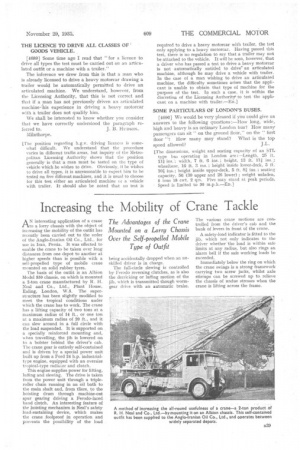Increasing the Mobility of Crane Tackle
Page 53

If you've noticed an error in this article please click here to report it so we can fix it.
The Advantages of the Crane Mounted on a Lorry Chassis Over the Self-propelled Mobile Type of Outfit
AN interesting application of a crane to a lorry chassis with the object of increasing the mobility of the outfit has recently been carried out to the order of the Anglo-Iranian Oil Co., Ltd., for use in Iran, Persia. It was effected to enable the crane to be taken over long distances from one depot to another at higher speeds than is possible with a self-propelled type of mobile crane mounted on solid rubber tyres.
The basis of the outfit is an Albion Model 550 chassis, on which is mounted a 2-ton crane manufactured by H. H. Neal and Co., Ltd., Plant House, Ealing, London, W.5. The superstructure has been slightly modified to meet the tropical conditions under which the crane has to work. The crane has a lifting capacity of two tons at a maximum radius of 14 ft., or one ton at a maximum radius of 20 ft., and it can slew around in a full circle with the load suspended. It is supported on a specially reinforced mounting and, when travelling, the jib is lowered on to a bolster behind the driver's cab. The crane gear is entirely self-contained and is driven by a special power unit built up from a Ford 24 h.p. industrialtype engine, equipped with an oversize tropical-type radiator and clutch.
This engine supplies power for lifting, lulling and slewing. The drive is taken from the power unit through a tripleroller chain running in an oil bath to the main shaft and, from there, to the hoisting drum through machine-cut spur gearing driving a Ferodo-faced band clutch. An interesting feature of the hoisting mechanism is Neal's safety load-sustaining device, which makes the crane foolproof in operation and prevents the possibility of the load being accidentally dropped when an unskilled driver is in charge.
The full-circle slewing is controlled by Ferodo reversing clutches, as is also the derricking or luffing motion of the jib, which is transmitted though wormgear drive with an automatic brake.
The various crane motions are controlled from the driver's cab and the bank of levers in front of the crane.
A safety-load indicator is fitted to the jib, which not only indicates to the driver whether -the load is within safe limits at any radius, but also rings an alarm bell if the safe working loads be exceeded.
Immediately below the ring on which the crane swings is a strong framework carrying two screw jacks, whilst axle stirrups can be screwed up to relieve the chassis of undue stresses when the crane is lifting across the frame.




























































































